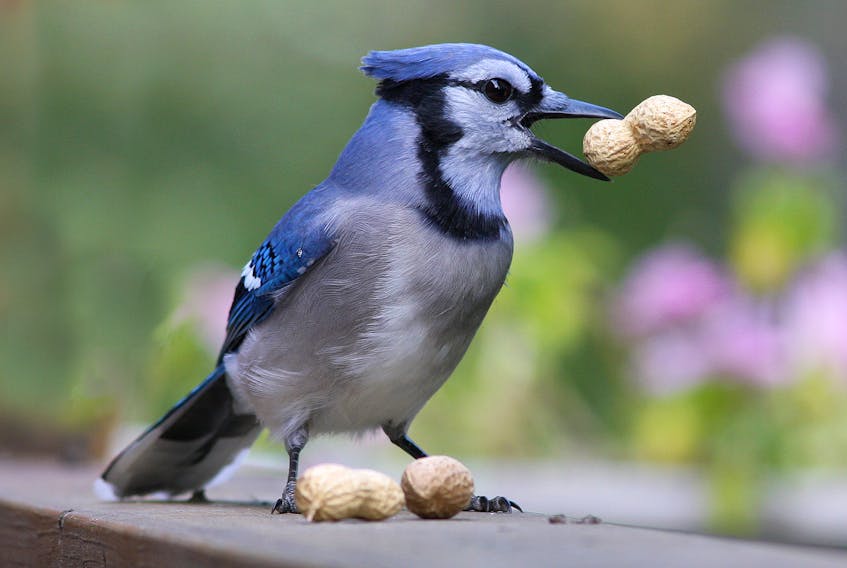Blue jays come into their own in the autumn season.
They are a conspicuous part of the avian landscape for anyone spending time outside these days. They have come out of hiding after a full summer of raising a family of new blue jays. Now that the young are fully grown up to be indistinguishable from their parents, the blue jays are living it up a little.
Autumn is when blue jays are at their boisterous best.
Blue jays are full of energy in autumn.
Many are in the process of migrating to warmer, less snowy winter environments in the mid United States. It is difficult to imagine blue jays crossing over Cabot Strait to reach the mainland but they do.
All across eastern Canada vast numbers of blue jays are undertaking the annual southward migration. In southern Ontario, for example, tens of thousands of blue jays are tallied migrating past regularly monitored migration stations.
The relatively mild winters of southern Ontario can and do support many blue jays but there is not enough room for them all. So many blue jays choose to leave Canada for the winter but they will come back again in the spring. Probably half of the blue jays nesting in Newfoundland stay for the winter. In Newfoundland most bird feeder watchers will not notice much difference in the local blue jay population throughout the year.
They are easily enticed to stay around for the winter with a steady supply of sunflower seeds.
In my backyard in west St. John’s blue jays are absent during the winter and most of the summer. But they make themselves known in the fall.
We offer them peanuts. Once blue jays get a taste for peanuts nothing else matters. At first they take the nut from the shell and actually eat it. But as we get deeper in to fall they hoard away more peanuts than they eat. It is an instinct for winter survival.
One of our five blue jays stands out from the rest. It discovered our soft spot. It learned to tap on the window of the sliding glass door on the back deck to get our attention. It taps twice then flies to the railing awaiting a reaction.
If the sliding door does not open he jumps down on the deck and taps again. If one of us is in the kitchen it invariably gets the peanuts. If it fails to work at the kitchen window it moves over to the living room window to see if it can spot us watching television. The windows there have an outside screen. It tries tapping the screen but get no sound so it sits on the back of a deck chair and looks directly in at us.
Sometimes it puffs up its breast feathers and shakes them to make itself look good. More often than not the result is a handful of peanuts being tossed out the back deck door. However, for much of the day there is no one present at either window to respond the blue jays demands.
So I guess it reverts to being a normal blue jay until it senses the movement behind the glass again. The blue jay has us wrapped around its finger so to speak. I know many readers of this column have their own gang of entertaining blue jays looking for peanuts.
As flocks of blue jays are flying over the treetops and heading down the coast on their migration route, so are the hawks.
Sharp-shinned hawks, merlins, northern harriers and other birds of prey are on the move following some of the same coastal routes as the blue jays. The desperation calls of blue jays in close pursuit of a sharp-shinned is a frequent sound during autumn. The blue jays are on the large size for the normal prey for these small hawks.
The blue jays know this and taunt the hawks by sitting just a couple trees away almost inviting the hawk to chase them. They can escape with a quick dive into the thickest part of the tree where the hawk does not want to go.
Shorebirds are migrating strong in September. These are favourite targets of the fast flying merlin. Merlins prefer the open air chase. I was admiring a pectoral sandpiper standing on a mound of dirt in a Goulds farm field.
These brown-coloured sandpipers specialize in finding insect life in mucky places including around manure piles. The sandpiper was very alert and so focused on me it did not see the merlin swoop in from behind. It probably never knew what hit it. It did not even struggle. The shock of the impact probably knocked the life out of it.
I felt guilty for causing the death of a nice looking sandpiper.
Such is life on the highway of autumn bird migration.
Bruce Mactavish is an environmental consultant and avid birdwatcher. He can be reached at [email protected].









